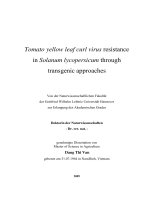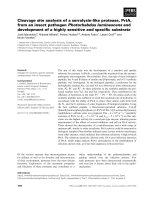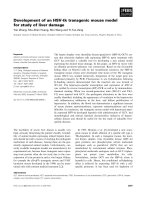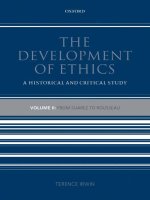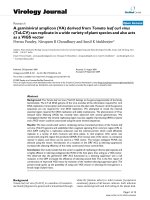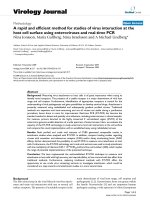Development of prediction equations for tomato leaf curl virus on tomato at different dates of planting using Logistic and Gompertz model
Bạn đang xem bản rút gọn của tài liệu. Xem và tải ngay bản đầy đủ của tài liệu tại đây (790.46 KB, 17 trang )
Int.J.Curr.Microbiol.App.Sci (2019) 8(5): 910-926
International Journal of Current Microbiology and Applied Sciences
ISSN: 2319-7706 Volume 8 Number 05 (2019)
Journal homepage:
Original Research Article
/>
Development of Prediction Equations for Tomato Leaf Curl Virus on
Tomato at Different Dates of Planting using Logistic and Gompertz Model
Madhumita Maity, Poly Saha* and Partha Sarathi Nath
Department of Plant Pathology, Bidhan Chandra Krishi Viswavdyalaya,
Nadia, West Bengal, India
*Corresponding author
ABSTRACT
Keywords
Area under disease
progress curve
(AUDPC), Dates of
planting (DOP),
Logistic and
gompertz model,
Prediction equation,
Tomato leaf curl
virus (ToLCV) and
weather parameters
Article Info
Accepted:
10 April 2019
Available Online:
10 May 2019
Tomato leaf curl virus (ToLCV) has become a major threat of Tomato (Solanum
lycopersicum) production in the world including tropical and subtropical tomato growing
regions due to its the endemic presence. The aim of this study is to develop a forewarning
strategy for the farmers. The components included in the experiment were, a susceptible
tomato variety “Patharkuchi” planted at 15 days interval starting from16th August to 29th
December during both the experimental year 2012-13 and 2013-14 under field condition.
Different dates of planting also allowed the plants to interact with the different weather
factors prevailed through out the growing period. Here, six independent weather variables
like maximum and minimum temperature and their differences, maximum and minimum
relative humidity and rainfall were considered and natural epiphytotic conditions were
permitted. Disease severity was measured and expressed as AUDPC. Prediction equations
were developed for each treatment separately through step down multiple regression
analysis which showed that different meteorological factors having different influence on
disease severity and these were explained after logistic and gompertz transformation of the
realized observed value of the disease severity (expressed as AUDPC). Logitic and
gompertz are the two transformation models through which the disease progress curve
move over time and its comparative expression are also presented graphically in this study.
Different dates of planting showed differences in disease severity. Lowest disease severity
was found when tomato was planted in (D1=16th August) (AUDPC=94.08) and 97.01)
and maximum disease severity was noticed (D4=30th September) (AUDPC=101.91 and
102.66) in the two respective years. Results disclosed that two models tested were not
equally fit for predicting disease progress curve in every treatments, though both the
models can be used to express disease progression but for linearization of AUDPC
following the two models (logit and gompit) showed that logit fit better than gompit for the
prediction of tomato leaf curl virus and this was confirmed by the low standard error
estimate (MSE) of logit in most of the treatments. The co-efficient of determination value
(R2) showed that variation in disease severity can be explained up to88.5% (maximum) in
logistic as well as 98.7% (maximum) in Gompertz with combined effect of the weather
variables included in the present study. The result also suggested with delay in planting
time the disease severity (AUDPC) increases. Minimum disease severity (AUDPC)
observed between planting time 16th August to 31st August. So, in West Bengal condition
planting of tomato between these periods may be recommended with an expectation of
minimum disease severity (AUDPC).
910
Int.J.Curr.Microbiol.App.Sci (2019) 8(5): 910-926
particularly in seasons/periods favoring
whitefly population build up (Pico et al.,
1996).
Introduction
Tomato (Lycopersicon esculentum Mill.) is
the second largest most widely grown
vegetable crops grown all over the world. In
India tomato is cultivated in Panjab, Haryana,
Uttar Pradesh, Maharashtra, Karnataka and
West Bengal. West Bengal is one of the
leading producers of tomato. It is enriched
with vitamins A and C as well as rich source
of minerals and organic acids. Tomato
cultivation has become increasingly popular
among the small and marginal farmers‟
because of its varied climatic tolerance and
able to fetch handsome amount of money.
For the last few years it appeared in epidemic
form in different part of the country and
facing the heavy toll to tomato. The reason
identified injurious strains of B. tabaci are
very difficult to manage, chemicals are the
only weapon to control the vectors, having
wide host range and continuous and
overlapping cultivation of tomato throughout
the year, its being very difficult to manage the
disease. So, the present research programme
is aimed to develop an economic management
technique. To achieve the objective, the crop
was planted at different planting dates to find
the incidence of ToLCV encountering
different
environmental situations, as
environment play an important role in the
population dynamics of the whitefly and with
the increase of the vector population disease
incidence also assumed to increase. Several
scientists Pruthi and Samuel (1942); Varma
(1959); Saklani and Mathai (1977) and
Ramos et al., (2002) and had recorded the
month wise vector populations. There was a
report by Shaheen (1983) revealed, early
sown tomato in February was seldom
infested, but that sown in April became
severely infested throughout the flowering
and fruiting stage resulting in 40 per cent crop
loss.
Tomato is affected by large number of viral
diseases. Among all the diseases reported,
tomato leaf curl virus (ToLCV), a geminivirus
(Geminiviridae: subgroup – III) is the most
important and destructive viral pathogen in
many parts of India (Vasudeva and Samraj,
1948: Sastry and Singh, 1973; Saikia and
Muniyappa, 1989; Harrison et al., 1991)
including West Bengal.
The disease is characterized by the curling
and twisting of leaves followed by marked
reduction in leaf size. The diseased plants
look pale and stunted due to shortening of
internodal length with more lateral branches
resulting in a bushy appearance (Vasudeva
and Sam Raj, 1948) and transmitted by
whitefly
Bemisia
tabaci
(Gennadius)
(Homoptera: Aleyrodidae) (Vasudeva and
Sam Raj, 1948; Butter and Rataul, 1973;
Muniyappa and Veeresh, 1984).
Severe infestation at the seedling stage
resulted in complete yield loss on autumn
crops sown in August. B. tabaci attacking
tomato in April-November with infestation
peak in August-October. This fact helps to
ponder over that variation in disease severity
in different month due to changing
environmental parameter in the field. So, the
experiment was set to find out the most
suitable date for planting of tomato
considering its relationship with the
prevailing meteorological parameters. Tomato
Yield loss due to ToLCV has been reported
50-70% depending upon the growing season
(Saikia and Muniyappa, 1989). Yield loss
exceeds 90 per cent, when infection occurred
within four weeks after transplanting in the
field (Sastry and Singh, 1973; Saikia and
Muniyappa, 1989). In many cases ToLCV
epidemics lead to abandonment of the crop,
911
Int.J.Curr.Microbiol.App.Sci (2019) 8(5): 910-926
susceptible tomato variety “Patharkuchi”
(indeterminate type) was chosen and the field
experiment was laid out at randomized block
design (RBD) using 10 treatments (different
dates of planting) in three replications, and
the plot size was 5×5 sq m. Tomato seedlings
of 30 days old were planted in each
experimental plot at a spacing of 60 cm × 30
cm. All recommended agronomic practices
followed and natural epiphytotic was
considered.
plant can be grown through out the year but
the severity of the disease varies during
different years possibly as a result of
changing
environmental
parameter.
Therefore, it is better to determine the nature
of relationship between the disease severity
and the weather parameters (depicted through
different dates of planting in this study) to
verify the linearity of disease progress in
simulation studies.
Linearization of disease progress curve is
essential to determine the rate of epidemic,
project future disease development and
estimated initial disease severity. For the
disease ToLCV in tomato, for linearization
suitable amenable used through suitable
transformation (Mayee and Datar, 1986).
Here, two transformation equations were used
for devising linearized mathematical models,
viz., logistic (Van der Plank, 1963) and
gompertz (Berger, 1981).
Treatment details
The seedlings were transplanted in the main
field starting from 16th August and at every 15
days interval and transplanting was done till
29th December and the same was followed for
the two consecutive experimental years.
Dates of transplanting were maintained same
for both the experimental years i.e 2012-13
and 2013-14
In this experiment, efforts put forth to
determine the influence of different weather
factors that act as a predisposing factor for the
development of vector population of the
disease and to formulate suitable prediction
equations through step down multiple
regression analysis of disease severity data
from different dates of planting considering
two different transformation models which
ultimately aim to develop suitable economic
management techniques through the choice of
right time of planting on the basis of predicted
disease severity involving the prevailing
weather parameters.
Dates of transplanting in the main field
D1 16-08-2012 and 16-08-2013
D2 31-08-2012 and 31-08-2013
D3 15-09-2012 and 15-09-2013
D4 30-09-2012 and 30-09-2013
D5 15-10-2012 and 15-10-2013
D6 30-10-2012 and 30-10-2013
D7 14-11-2012 and 14-11-2013
D8 29-11-2012 and 29-11-2013
D9 14-12-2012 and 14-12-2013
D10 29-12-2012 and 29-12-2013
Validation of the pathogenicity of the
pathogen
Materials and Methods
The diseased sample was collected from the
field and sent to the Division of Plant
Virology, IARI, New Delhi for identification
of the pathogen and it was confirmed that the
pathogen was Tomato leaf curl virus and its
pathogenicity was proved artificially.
Investigation was carried out at the University
Farm Kalyani, Bidhan Chandra Krishi
Viswavidyalaya, Nadia, West Bengal, during
2012-13 and 2013-14. The soil of the farm
was sandy loam in texture (sand 52.74%, silt
19.60% and clay 25.66%) and belongs to the
hyperthermic family with the pH 7.2. One
912
Int.J.Curr.Microbiol.App.Sci (2019) 8(5): 910-926
Yi =severity at 1st observation,
Xi = Time (days) at first observation
N = Total number of observation
Disease scoring
Percentage of infection in each plot, the
number of leaf curl infected plants was noted
by visual observation.
Transformation models used under study
The number of leaf curl infected plants in
each plot, was observed on 15th, 30th, 45th,
60th, 75th and 90th days after transplanting.
The data obtained were subjected to both
Gompertz (Kranz, 1974; Berger, 1981) and
logistic transformation (Vander Plank 1963)
using the following equation:
The severity of the disease was measured on
the basis of scale as follows (Friedmann et al.,
1998)
Logistic = Logit (Y) = ln [Y/1-Y)]
Gompertz = gompit (y) = - ln [-ln(y)]
Scale
0
1
3
5
7
9
Where Y = Proportion of disease tissue.
Description
No visible symptom
Very slight yellowing of leaflet &
margin on apical leaf
some yellowing & minor curling of
leaflet ends
A wide range of yellowing curling
& cupping of, reduction of leaf
size, plant continues to develop
Very severe plant stunting &
yellowing
Pronounced leaf cupping &curling,
plant growth stops
Apparent infection rate calculated either as
logistic infection rate (r) or gempertz
infection rate (k), for each increment of time
determined using the respective formulae:
dx/dt =Xr (1-x) in case of polycyclic
pathogen, Vander Plank (1963)
X= the proportion of tissue diseased
r = apparent infection rate,
(1-x)= the proportion of tissue available for
infection, exp. In = Logarithms (to the base
e).
PDI was computed using the following
formula:
If the total amount of “X” of capital interest
varies with time „t‟, then dt means a very
small interval of time and dx is the very small
bit that X increase in that interval.
Sum of all numerical
ratings
Percent
x
Disease Index Total number of leaf
100
(PDI) =
observed x maximum
rating
a. k, c, b and 0.05 = constant
The best fit of a specific model to the
was determined by comparison of the
parameters ('r' for logistic and 'k'
Gompertz), which is nothing but
regression coefficient 'b', y-intercept (a).
Then the disease severity records were
averaged over the three replications and
disease progress curves were plotted. For each
replication the area under disease progress
curves was calculated as per Wilcoxon et al.,
(1975). The formula was used and follows:
data
rate
for
the
Weather parameters and statistical analysis
AUDPC = ∑ [(Yi + 1 + yi)/ 2 (Xi + 1 - Xi)]
The available meteorological data on weather
variables viz. maximum temperature (T max)
i=1
913
Int.J.Curr.Microbiol.App.Sci (2019) 8(5): 910-926
and minimum temperature (T min) and their
differences (Tmax-Tmin), maximum (RH
max) and minimum relative humidity
(RHmin) and rainfall (R)were collected from
AICRP on Agro-Meteorology, Bidhan
Chandra Krishi Viswavidyalaya, Kalyani,
West Bengal. Seven days mean of those
weather parameter (variables) were recorded
at morning (06.35) except for the seven days
cumulative rainfall and the number of rainy
days for the entire period of disease
assessment were worked out.
The results indicated that, lowest disease
severity was found when tomato was planted
in (D1=16th August) (AUDPC=94.08) and
(AUDPC: 97.01) respectively for the year
2012-13 and 2013-14 (Table 1 and 2).
Followed by (D2= 31st August) (AUDPC=
95.02 and AUDPC= 97.80) in both the
experimental year correspondingly (Table 1
and 2). The disease severity started to
increase from the next dates of planting and
found maximum at (D4=30th September)
(AUDPC=101.91). After that the disease
severity started to reduce from the (D5=15th
October) (AUDPC = 99.84) and continued
upto (D10=29th December) (AUDPC =
95.13) (Table 1).
To predict the disease development, multiple
regression equations were computed by using
SPSS computer software. Coefficient of
determination (R2) was also calculated and
tested for significance at 1% level of
probability. Disease prediction models were
developed using the following equation:
Similar trend is followed in the progression of
disease over the year 2013-14. Here, also
maximum disease severity observed in (D4 =
30th September: AUDPC =102.66) followed
by (D5 = 15thOctober: AUDPC = 101.30) and
D6 = 30th October: AUDPC = 101.05) (Table
2).
Y (PDI) = a + biXi + e
Where, Y= predicted disease index; a=
intercept; bi = regression coefficient for Xi (i=
n) and Xi = independent variable (i=1 n i.e
weather parameters); e= random error.
Sakalani and Mathai (1977), reported that
October to mid December was the most
effective time for planting tomato followed by
January to first March in Pantnagar (UP). In
March to September sown crop ToLCV
appeared within 25 to 45 days after planting
whereas appearance of ToLCV symptom was
delayed when the crop was sown during
October to mid December.
Step down multiple regression analysis was
applied to disease severity data. The goodness
of fit to the model so obtained was evaluated
by co-efficient determination (R2); adjusted
determination of co-efficient (R2adj) and error
means square (MSE). So, a final evaluation of
the model was determined based on the above
three criteria (Berenson et al 1983, Coakley et
al., 1988).
Our finding also in agreement to the result
revealed by Mahajan (2001), where 1st
September planting was found to be suitable
to get the stable yield from tomato with
minimum infection by ToLCV. In later dates
of planting, though recorded less disease
incidence but produce lower yield.
Results and Discussion
Tomato variety „Patharkunchi‟ was used in
this experiment and 30 days old seedlings
were planted in 10 different date starting from
16th august to 29th December at 15 days
interval in two consecutive years i.e 2012-13
and 2013-14 to find out the suitable date of
planting for minimum disease severity.
Less incidence on later transplanted and more
incidence on early transplanted tomato crops
during autumn season have been reported by
914
Int.J.Curr.Microbiol.App.Sci (2019) 8(5): 910-926
many workers including Saikia and
Muniyappa (1989), Polizzi et al., (1994);
Borah and Bordoloi (1998) in also in support
with the findings in the present study.
better than the other into a specific plant
pathosystem.
The AUDPC data obtained was subjected to
both gompertz and logistic transformation and
equations were developed and presented in
Table 1 and 2. Both the transformation
models showed the mode of spread of the
disease over time (Fig. 1) and provide a
comparative study through which the
scientists could depict which model suits
better to describe the spread of the disease.
Our results presented in Tables 1 and 2
concluded that both the model can fit to
depict the disease progression over time but
lower standard errors of logit model
suggested that logit fit better than gompitin
case of tomato leaf curl virus. Among the
gompit transformation, it was best fit in
D1(16th August) and D2 (31 August) planting
with (a=6.713 and 14.279b=0.021 and 0.015c
=0.850 and 0.884 with MSE value=0.004 and
0.002) in the year 2012-13 and 201314respectively for D1.Similar trends followed
by D2 (31st August) and D5 (15 October)
planting in both the year. But for the rest of
the treatments low MSE value of logit proved
that it suits better to predict the disease
progression than high MSE value of gompit.
In this experiment, six independent variables
i.e T max, T min, Tmax-min, RH max, RH
min (average taken and represented as only
RH) and total rainfall (RF) were considered
and their influence on the disease
development were established through the
development of prediction equations and the
procedure followed was step down multiple
regression analysis.
Prediction equations
The result revealed that there was a positive
significant correlation between the disease
severity and T mean and mean RH and total
rainfall with the progression of the disease
through AUDPC following the two different
models tested and it remain true for all the
treatments in the following year experiment
also. In this situation, the only way to
determine the best fit model is the comparison
between low standard error of the estimate
(MSE) table 3 and 4.
In the year, 2012-13 treatment D1 (16th
August), D2 (31st August), and D5 (15th
October) Gompertz model showed low MSE
value than logit, so, progression of the disease
in this dates of planting they can be best
explained through gompit model and for the
rest of the treatments logit model was found
better (Table 3 and Fig. 1).
Plant disease development is a dynamic
process and depends upon the interactions
between the host, pathogen and the
environment. Here, one more factor is
included i.e the vector. The variation in any
one of the factor influence the disease
development. Here, environmental variation
was considered as an independent variable in
the regression equation to develop prediction
equations over the two experimental years
and both the model logit and gompit was
considered to linearize the disease progress
curves. Depending upon the nature of the
disease progress curves, one model found fit
During 2013-14, predicted disease index
following logit model showing same pattern
as the previous year. Differences observed in
case of D1 (16th August), D2 (31st August),
and D5 (15th October) where gompit model
suits best to describe disease progression
(Table 4). From the data presented in the table
3 and 4 representing the respective
experimental year conclude that among the
environmental variable tested T mean, RH
915
Int.J.Curr.Microbiol.App.Sci (2019) 8(5): 910-926
and rainfall all are positively and significantly
correlated with disease severity.
to fit better in the expression of disease
progress curve.
Several workers worked on the relationship
between the weather parameters and severity
of ToLCV, whose report supports our
observation. Singh et al., (1999) who reported
that spread of the disease was rapid with the
maximum temperature of 28.7 to 30.8 0C and
minimum temperature of 15.1 – 22.3 0C, 2.0
mm rainfall and maximum minimum relative
humidity of 88-91.30 and 44.6 – 69.6 per
cent, respectively.
From the above equations and the literature
cited it is observed that, T mean, mean RH
and rainfall are related positively and
significantly with the disease severity in both
the year and plays the major role in both the
year. But for more precise conclusion further
study has been needed considering few more
factors like wind velocity, Bright sunshine
hour, mean cloudiness etc. those may have
direct or indirect effect on either vector
population or on the host, major components
of the phyto epidemics.
Yassin (1975) reported the negative
correlation between ToLCV incidence and
wind direction. Nitzany (1975) testified
relationship between RH and ToLCV
outbreak and concluded most favourable is T
mean 300C and RH< 60% but (Makkouk et
al., 1979) reported ToLCV outbreaks in the
coastal region with a mean relative humidity
more than 60 per cent. Similar type of
experiment conducted by Saha and Das
(2014) on chemical management of tomato
early blight contradicts our result in terms of
disease progression where gompit was found
Coefficient of determination (R2) value
indicated that the predicted value of PDI can
be explained 35.8 percent to 88.5 percent of
the total variation in the PDI in case logit
transformation scale and Gompit exhibit 51.3
percent to 98.7 percent variation in the
prediction of disease severity in the year
2012-13. In 2013-14, this variation was from
62.3 percent to 86.7 percent under logit and
63.6 percent to 86.9 percent under Gompit
respectively.
Table.1 Distribution of tomato leaf curl disease on tomato subjecting to logit and Gompit
transformation at different dates of planting during 2012-13
Treatments
D1
D2
D3
D4
D5
D6
D7
D8
D9
D10
AUDPC
2012-13
94.08
95.02
96.28
101.91
99.84
99.30
98.02
96.31
94.91
95.13
Logit transformation value
k
a
b
MSE
2.312
3.091 (-)0.526
0.005
2.719
2.984 (-)0.522
0.003
2.782
2.498 (-)0.496
0.003
4.432
3.462 (-) 0.866 0.001
4.553
3.461 (-)0.731
0.006
3.665
3.451 (-)0.813
0.003
3.077
3.667 (-)0.884
0.005
6.317
3.912 (-)0.540
0.003
2.112
3.166 (-)0.661
0.002
2.391
3.679 (-)0.750
0.001
Gompit transformation value
a
b
c
MSE
6.713
0.021 0.850
0.004
5.453
0.032 0.822
0.001
8.213
0.040 0.864
0.003
7.023
0.037 0.710
0.004
10.885 0.022 0.791
0.003
8.093
0.031 0.775
0.014
5.627
0.029 0.733
0.013
5.602
0.014 0.977
0.018
3.122
0.038 0.751
0.002
7.188
0.015 0.805
0.047
AUDPC= Area Under Disease Progress Curve, MSE= Error mean squareD1=16th August planting. D2=31st August planting,
D3=15th September planting, D4= 30th September planting, D5=15th October planting, D6= 30th October planting D7= 14th
November planting, D8= 29th November planting, D9=14th December planting, D10= 29th December planting
916
Int.J.Curr.Microbiol.App.Sci (2019) 8(5): 910-926
Table.2 Distribution of tomato leaf curl disease on tomato subjecting to logit and gompit
transformation at different dates of planting during 2013-14
Treatments
D1
D2
D3
D4
D5
D6
D7
D8
D9
D10
AUDPC
2013-14
97.01
97.80
99.12
102.66
101.30
101.05
99.99
98.78
97.63
97.76
K
9.076
2.983
1.743
3.502
3.774
9.910
3.681
2.223
1.837
1.438
Logit transformation value
a
b
MSE
6.285
(-)0.363
0.009
2.566
(-) 0.435
0.003
2.225
(-)0.752
0.001
2.784
(-)0.650
0.002
2.566
(-)0.563
0.005
3.828
(-)0.410
0.002
3.293
(-) 0.492
0.007
2.449
(-) 0.479
0.004
2.660
(-)0.541
0.004
3.064
(-)0.674
0.007
Gompit transformation value
a
b
c
MSE
14.279
0.015
0.884
0.002
4.803
0.062
0.840
0.002
2.172
0.169
0.709
0.010
5.619
0.063
0.772
0.005
5.068
0.065
0.749
0.002
9.683
0.023
0.852
0.003
5.947
0.030
0.834
0.012
3.506
0.067
0.811
0.015
5.056
0.031
0.850
0.006
1.665
0.059
0.709
0.026
AUDPC= Area Under Disease Progress Curve, MSE= Error mean squareD1=16th August planting. D2=31st August planting, D3=15th September
planting, D4= 30th September planting, D5=15th October planting, D6= 30th October planting D7= 14th November planting, D8= 29th November
planting, D9=14th December planting, D10= 29th December planting
Table.3 Step down multiple regression analysis for developing prediction equations depicted
from logistic and gompertz transformation of tomato leaf curl disease on tomato at different
dates of planting in relation to weather parameter recorded during 2012-13
Treat
ments
Regression equation
D1
(L)→Ỳ= -0.797+0.804 Tmean+ 0.674 RF+ 0.681 RH
(G)→Ỳ= - 0.771 + 0.793Tmean+0.537 RF +0.445 RH
(L)→Ỳ= -0.995+ 0.932Tmean+0.659 RF +0.930 RH
(G)→Ỳ= - 0.8975 + 0. 914Tmean+0.532 RF+0.876 RH
(L)→Ỳ= 0.455+ 0.752 Tmean+0.790 RF+0.495 RH
(G)→Ỳ= - 0.394 + 0.646Tmean+0.630RF + 0.564 RH
(L)→Ỳ= -0.951 + 0.077Tmean+0.567 RF +0.480 RH
(G)→Ỳ= - 0.956 + 0. 718Tmean+0.852RF +0.952 RH
(L)→Ỳ= -0.759+0.797 Tmean+0.868RF + 0.647 RH
(G)→Ỳ= -0.828 + 0.520Tmean+0.669RF + 0.548 RH
(L)→Ỳ= -0.775+0.567 Tmean+0.845RF + 0.567 RH
(G)→Ỳ= - 0.665 + 0.685 Tmean+0.348RF + 0.607 RH
(L)→Ỳ= -0.876+ 0.465 Tmean+0.898RF + 0.647 RH
(G)→Ỳ= - 0.715 + 0.875 Tmea +0.678RF + 0.567 RH
(L)→Ỳ=-0.845+ +0.374 Tmean+0.492RF + 0.004 RH
(G)→Ỳ= - 0.059 + 0.346Tmean + 0.574 RF+0.176 RH
(L)→Ỳ= - 0.894+0.678 Tmean+0.307RF + 0.469 RH
(G)→Ỳ= - 0.769+ 0.657 Tmean+0.678RF + 0.147 RH
(L)→Ỳ= -0.768 + 0.387 Tmean+0.748 RF + 0.289 RH
(G)→Ỳ= - 0.669+ 0.797 Tmean+0.467 RF + 0.379 RH
D2
D3
D4
D5
D6
D7
D8
D9
D10
Coefficient
of Adjust
determination
ed (R2)
(R2)
0.854**
0.776
0.918**
0.843
0.358
0.348
0.794*
0.737
0.478
0.426
0.548
0.537
0.883**
0.301
0.587
0.609
0.658
0.439
0.757*
0.578
0.866**
0.765
0.987**
0.890
0.782*
0.675
0.513
0.399
0.885**
0.788
0.740*
0.695
0.848**
0.754
0.769*
0.583
0.854**
0.778
0.713*
0.684
Std. Error
of
the
estimate
0.465
0.218
0.378
0.167
0.366
0.356
0.256
0.478
0.477
0.203
0.657
0.765
0.246
0.477
0.493
0.674
0.224
0.228
0.356
0.567
L= Prediction equation depicted from logistic transformation, G= Prediction equation depicted from gompertz transformation, RH=
Relative humidity, **= Significant at 1% level of probability,*= Significant at 5 % level of probabilityD1=16th August planting.
D2=31st August planting, D3=15th September planting, D4= 30th September planting, D5=15th October planting, D6= 30th October
planting D7= 14th November planting, D8= 29th November planting, D9=14th December planting, D10= 29th December planting
917
Int.J.Curr.Microbiol.App.Sci (2019) 8(5): 910-926
Table.4 Step down multiple regression analysis for developing prediction equations depicted
from logistic and gompertz transformation of tomato leaf curl disease on tomato at different
dates of planting in relation to weather parameter recorded during 2013-14
Treat
Regression equation
Coefficient
ments
determination
of Adjusted
(R2)
2
(R )**
D1
D2
D3
D4
D5
D6
D7
D8
D9
D10
Std. Error
of
estimate
(L)→Ỳ= -0.675+ 0.546 Tmean+0.478RF + 0.086 RH
0.695
0.527
0.047
(G)→Ỳ=-0.589+0.475 Tmean +0.034RH +0.003 RH
0.755*
0.686
0.088
(L)→Ỳ= - 0.456 + 0.675 Tmean+0.376RF + 0.047 RH
0.636
0.537
0.086
(G)→Ỳ= - 0.568 + 0.567 Tmean+0.578RF + 0.056 RH
0.846**
0.567
0.079
(L)→Ỳ= - 0.567 + 0.675 Tmean+0.345 RF + 0.897 RH
0.623
0.512
0.026
(G)→ Ỳ=- 0.886 + 0.567 Tmean+0.098RF + 0.265 RH
0.869**
0.563
0.015
(L)→Ỳ = -0.345+ 0.456Tmean + 0.479RF + 0.548 RH
0.854**
0.721
0.254
(G)→= - 0.453+ 0.398Tmean+0.287 RF+ 0.145RH
0.698
0.667
0.345
(L)→ Ỳ= - 0.167 + 0.897 Tmean+ 0.790RF + 0.134 RH
0.687
0.576
0.142
(G)→ Ỳ= - 0.452 + 0.768 Tmean+ 0.567 RF + 0.754 RH
0.773*
0.678
0.037
(L)→Ỳ= -0.342 +0.303 Tmean+ 0.472 RF + 0.493 RH
0.863**
0.673
0.243
(G)→Ỳ= -0.267 + 0.483 Tmean+ 0.437 RF + 0.376 RH
0.773*
0.603
0.354
(L)→Ỳ = -0.473 + 0.876 Tmean+ 0.365 RF + 0.504 RH
0.753*
0.639
0.187
(G)→Ỳ = - 0.493 + 0.456 Tmean+ 0.404 RF + 0.289 RH
0.641**
0.652
0.276
(L)→Ỳ= -0.578 + 0.389 Tmean+ 0.487 RF + 0.010 RH
0786*
0.609
0.036
(G)→Ỳ= - 0.678 +0.393 Tmean+ 0.240 RF + 0.288 RH
0.636
0.553
0.156
(L)→Ỳ= - 0.765 +0.678 Tmean+ 0.358 RF + 0.987 RH
0.867**
0.478
0.273
(G)→Ỳ= - 0.868 +0.138 Tmean+ 0.584 RF + 0.596 RH
0.676
0.367
0.392
(L)→Ỳ= -0.384+ 0.567 Tmean+ 0.247 RF + 0.654 RH
0.787*
0.776
0.398
(G)→Ỳ=- 0.370 + +0.456 Tmean+ 0.467 RF + 0.567 RH
0.676
0.568
0.465
L= Prediction equation depicted from logistic transformation, G= Prediction equation depicted from gompertz transformation, RH=
Relative humidity, BSH= Bright sunshine hour, VP = Vapour pressure, **= Significant at 1% level of probability,*= Singnificant at 5%
level of probabilityD1=16th August planting. D2=31st August planting, D3=15th September planting, D4= 30th September planting, D5=15th
October planting, D6= 30th October planting D7= 14th November planting, D8= 29th November planting, D9=14th December planting, D10=
29th December planting
918
the
Int.J.Curr.Microbiol.App.Sci (2019) 8(5): 910-926
Fig.1 Comparison of observed and predicted disease progress curve under logistic and gompertz
model on different dates of transplanting during 2012-13 and 2013-14
919
Int.J.Curr.Microbiol.App.Sci (2019) 8(5): 910-926
920
Int.J.Curr.Microbiol.App.Sci (2019) 8(5): 910-926
921
Int.J.Curr.Microbiol.App.Sci (2019) 8(5): 910-926
922
Int.J.Curr.Microbiol.App.Sci (2019) 8(5): 910-926
923
Int.J.Curr.Microbiol.App.Sci (2019) 8(5): 910-926
The best fit of one model over the other has
been attained by comparison of the regression
parameter Y intercept (Fried et al., 1979);
R2(Berger, 1981 and Waggoner, 1986)
Among the two transformation model, high
co-efficient of determination value (R2) of
logit and low standard error estimate of logit
in both the year prove that logit fit better than
gompit in case of tomato leaf curl virua when
planted in different dates of planting. In both
the year, 2012-13, high co-efficient of
determination value (R2) of gompit in case of
D1, D2 and D5 plot may fit better than logit
and low standard error estimate of gompit
prove that gompit fit better in this situation
(Table 3 and 4). The estimation and
comparison of all the parameters in the
present investigation resulted in fitting of 88.5
percent and 98.7 percent of the disease
progress curves into the logistic and gompertz
models, respectively.
1.43 to 9.9 logistic and 1.66 to 14.29gompertz
apparent infection rates, which are generally
encountered under different environmental
conditions. These curves will have wider
practical applicability in an integrated disease
management program, while taking a decision
as to whether to take prophylactic measures or
not.
References
Berenson, M., Sevine, D. and Goldstein, M.
1983. Intermediate Statistical Methods
and application. Prentice Hall. XVII
pp. 579.
Berger, R.D., 1981. Comparison of Gompertz
and Logistic equations to describe
disease progress. Phytopathology.71:
716-719.
Borah, R.K., and Bordoloi, D.K. 1998.
Influence of planting time on the
incidence of leaf curl virus disease and
whitefly population on tomato. Indian
Journal of Virology. 14 (1):71-73.
Butter, N.S., and Rataul, H.S.1973. Control of
tomato leaf curl virus (ToLCV) in
tomatoes by controlling whitefly,
Bemisia tabaci, Genn. by mineral oil
sprays. Current Science. 42: 846-865.
Coakley, S.M., Mc. Daniel, L.R. and Shaner,
G. 1988. Predicting stripe rust severity
on winter wheat using an improved
method for analysing meteorological
and rust data. Phytopathology.78: 543550.
Fried, P.M., Mackenzie, D.R. and Nelson,
R.R. 1979. Disease progress curves of
Erysiphe
graminis
f.sp.triticion
chancellor wheat and four multilines.
Phytopathology. 95: 151-166.
Friedmann, M., Lapidot, M., Cohen, S. and
Pilowsky, M. 1998. A novel source of
resistance to tomato yellow leaf curl
virus exhibiting a symptomless
reaction to viral infection. Journal of
American Society of Horticultural
From the findings, it can be concluded that in
early planting the disease severity is less that
the late planting. Planting between 16th
August and 31st August found to be best time
for planting of tomato under indo-gangetic
plains of West Bengal. This finding was also
strongly supported by Mohanty and Basu,
1987. Within these planting dates and in
15thoctober planting disease progression was
best defined through gompit model. For the
rest of the planting dates logit model was
found to fit better. Our experiments had
shown good correlation between the two
models (coefficient of determination value
0.88 and 0.87 in logistic as well as 0.98 in
Gompertz model). Where gompertz value
showed 0.98, it means in case of D6 (30th
October planting) there is a change of 98
percent disease severity with the positive
significant effect of T mean, RH mean and
rainfall in combination. It is also applicable
under different situations, since the present
disease progress curves encompass a wide
spectrum of disease severities ranging from
924
Int.J.Curr.Microbiol.App.Sci (2019) 8(5): 910-926
Science. 123: 1004–1007.
Harrison, B.D., Muniyappa, V., Swanson,
M.M., Roberts, I.M. and Robinson,
D.J.
1991.
Recognition
and
differentiation of seven whitefly
transmitted gemini viruses from India
and their relationships to African
cassava
mosaic
and
Thailand
mungbean yellow mosaic viruses.
Annals of Applied Biology.118:299308.
Kranz, J., 1974. The role and scope of
mathematical analyse and modeling in
epidemiology. In Epidemics and Plant
Diseases, Mathematical Analysis and
Modeling (Ed. J. Kranz), pp. 7-54
Sringer, New York.
Mahajan, Rajeev. 2001. Investigation on leaf
curl virus of tomato (Lycopersicon
esculentum). Thesis for M.Sc (Ag)
Plant Pathology. Sher-E-Kashmer
university of agricultural sciences and
technology Jammu. Faculty of
Agriculture. R.S. Pura.
Makkouk, K.M., Shehab, S. and Majdalani,
S.E.1979. Tomato yellow leaf curl
incidence,
yield
losses
and
transmission
in
Lebanon.
PhytopathologischeZeitschrift.96:263267.
Mayee, C.D., and Datar, V.V. 1986.
Phytopathometry. Technical Buletien1 (Special Bulletin -3), Marathwada
Agricultural University Parbhani,
India. 218pp.
Mohanty, A.K. and Basu, A.N. 1987. Biology
of whitefly vector, Bemisia tabaci
Genn. On four host plants throughout
the year. Journal of Entomological
Research.11: 15-18
Muniyappa, V. and Veeresh, G.K. 1984. Plant
virus
diseases
transmitted
by
whiteflies in Karnataka. Proceedings
of Indian Academy of Sciences.93:
397-406.
Nitzany, F.E. 1975. Tomato yellow leaf curl
virus. Phytopathologia Mediterrania.
14: 127- 129.
Pico, B., Diez, M.J. and Nez, F. 1996. Viral
diseases causing the greatest economic
losses to the tomato crop. II. The
tomato yellow leaf curl virus–a
review. Science Horticulture. 67: 151196.
Polizzi, G. and Asero, C. 1994. Epidemiology
and incidence of tomato yellow leaf
curl virus (TYLCV) in greenhouse
protected by screens in Italy. Second
symposium on protected cultivation of
Solanacea in mild winter climates,
Adana, Turkey, 13–16 April 1993
[edited by Cockshull, K. E., Tuzel, Y.,
Gul, A.]. Acta Horticulture. 366: 345–
352.
Pruthi, H.S. and Samuel, C.K. 1942.
Entomological investigation on the
leaf curl disease of tobacco in
Northern India- V. Biology and
population of the whitefly vector
(Bemisia tabaci, Genn.) in relation to
the incidence of the disease. Indian
Journal of Agricultural Sciences.12:
35-37.
Ramos,N., Fernandes, J.E., Arsenio, A.F.,
Mangerico, S. and Neto,E. 2002.
Control of Bemisia tabaci/tomato
yellow leaf curl virus complex in
tomato nurseries in Portual. EEPO
workshop on tomato leaf curl begomo
viruses (TYLCV) Faro (PT).
Saha, P. and Das, S. 2014. Development of
prediction equations for early blight
leaf spot on tomato under different
fungicides treatments. Journal of
Agrometeorology. 16 (1): 130-136.
Saikia, A.K. and Muniyappa, V. 1989.
Epidemiology and control of tomato
leaf curl virus in Southern India.
Tropical Agriculture. 66:350-354.
Saklani, A.U.D. and Mathai, P.J. 1977. Effect
of date of planting on leaf curl disease
of tomato. Indian Journal of
925
Int.J.Curr.Microbiol.App.Sci (2019) 8(5): 910-926
Horticulture. 34: 64-68.
Sastry, K.S.M. and Singh, S.J. 1973.
Assessment of loss in tomato by
tomato leaf curl virus. Indian Journal
of Mycology and Plant Pathology. 27:
274-297.
Shaheen, A.H. 1983. Some ecological studies
on whitefly (Bemisia tabaci Genn.)
infesting tomato at Mansoura district.
Egypt
Acta
Phytopathologica
Academiae Scientiarum Hungaricae.
17: 145-155.
Shanab, L.M. and Awad-Allah, S.S. 1982.
Studies on whitefly (Bemisia tabaci
Genn.) infesting tomato at Mansoura
district. Egypt Acta Phytopathologica
Academia Scientiarumhungricae.17:
145-155.
Singh, U.C., Singh, R. and Nagaich, K.N.
1999. Evaluation of tomato varieties
against jassid (Empoascadevastans),
whitefly (Bemisia tabaci) and leaf
curl. Indian Journal of Entomology.
61(2): 173-176.
Vander Plank, J.E.1963. Plant Disease
Epidemics and control. Academic
Press. New York. 349 pp.
Varma, J.P. 1959. Tomato leaf curl: ICAR
Proceedings, Seminar on diseases of
horticultural plants (Simla) pp 182200.
Vasudeva, R.S. and Sam, Raj. 1948. Leaf curl
disease of tomato. Phytopathology
18:364-369.
Waggoner, P.E. 1986. Progress curves of
foliar diseases: Their interpretation
and use. Pages 3-37, In: Plant Disease
Epidemiology: Population Dynamics
and Management Vol. I. Leonard, K.J.
and Fry, E.W. ed., MacMillan
publishing Co., New York.372pp.
Wilcoxcon, R.D., Shovm, B. and Asit,
A.A.1975. Evaluation of wheat
cultivar for the ability to retard
development of stem rust. Annals of
Applied Biology. 86(2): 275-287.
Yassin, A.M., 1975. Epidemics and chemical
control of leaf curl disease of tomato
in Sudan. Experimental Agriculture.
11: 161-165.
How to cite this article:
Madhumita Maity, PolySaha and Partha Sarathi Nath. 2019. Development of Prediction
Equations for Tomato Leaf Curl Virus on Tomato at Different Dates of Planting using Logistic
and Gompertz Model. Int.J.Curr.Microbiol.App.Sci. 8(05): 910-926.
doi: />
926
